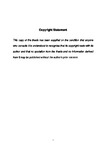PLANT MEDIATED EFFECTS OF EARTHWORMS ON APHID DYNAMICS
| dc.contributor.supervisor | Blackshaw, Rod | |
| dc.contributor.author | Kadir, Nawzad | |
| dc.contributor.other | School of Biological and Marine Sciences | en_US |
| dc.date.accessioned | 2014-06-18T13:07:25Z | |
| dc.date.available | 2014-06-18T13:07:25Z | |
| dc.date.issued | 2014 | |
| dc.date.issued | 2014 | |
| dc.identifier | 10223590 | en_US |
| dc.identifier.uri | http://hdl.handle.net/10026.1/3037 | |
| dc.description.abstract |
The individual and combined effects of the endogeic and epigeic groups of earthworms on the growth of Chinese cabbage (Brassica rapa), and on the subsequent growth and development of the generalist sap-sucking herbivore Myzus persicae were determined in separate pot experiments. Many previous studies have investigated the relationship between soil biodiversity and aboveground plants, but few researches have considered the indirect interaction between soil biota and above-ground aphids. In this study the individual effects of Aporrectodea rosea and Allolobophora chlorotica and the combined effects of A. rosea and A. chlorotica, Aporrectodea caliginosa and Satchellius mammalis, A. chlorotica and S. mammalis, and A. rosea, A. caliginosa, Lumbricus rubellus and S. mammalis on plant morphology and physiology and aphid development (nymphs day-1, fecundity and number of adults) were investigated. Plant growth was affected by the presence of A. rosea which caused increases in plant biomass, height of plant, leaf surface area and specific leaf area (SLA). Mean number of leaves per plant was unaffected by worm density. In contrast, increasing density of A. chlorotica had no effect on any aspect of plant performance. The combined effect of A. rosea and A. chlorotica resulted in a similar increase in plant biomass to A. rosea alone. While the combined effects of A. caliginosa and Satchellius mammalis, A. chlorotica and S. mammalis and A. rosea, A. caliginosa, L. rubellus and S. mammalis caused increases in all plant parameters except leaf number. Additionally, the individual effect of A. rosea and the combined effects of A. caliginosa and S. mammalis, A. chlorotica & S. mammalis and A. rosea and A. caliginosa, L. rubellus and S. mammalis resulted in increased in leaf nitrogen concentration. Aphid development was also affected by the presence of earthworms. The nymphs day-1, fecundity and numbers of adults were significantly increased with increases in earthworm densities. The interaction between all groups of earthworms and their influence on aphid growth showed that the combined effect of two different groups was greater than the individual groups. Proteomic techniques were used to compare protein patterns in the plants. The combined effects of A. caliginosa and S. mammalis, A. chlorotica and S. mammalis, A. rosea, A. caliginosa, L. rubellus and S. mammalis earthworms on plant resulted in differences in number and kind of protein between plant treated with earthworms and the control, but no significant difference in proteins volume. Effects of earthworms on plant growth and aphid development are shown to be modified by increasing density and interactions between different species and functional groups of earthworms. | en_US |
| dc.description.sponsorship | Ministry of higher education/Iraq | en_US |
| dc.language.iso | en | en_US |
| dc.publisher | Plymouth University | en_US |
| dc.subject | Aphids | |
| dc.subject | Brassica | |
| dc.subject | Nitrogen | |
| dc.subject | Protein | |
| dc.subject | Earthworms | en_US |
| dc.title | PLANT MEDIATED EFFECTS OF EARTHWORMS ON APHID DYNAMICS | en_US |
| dc.type | Thesis | |
| plymouth.version | Full version | en_US |
| dc.identifier.doi | http://dx.doi.org/10.24382/4552 |
Files in this item
This item appears in the following Collection(s)
-
01 Research Theses Main Collection
Research Theses Main


